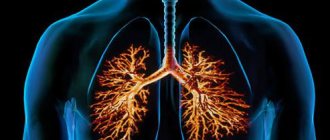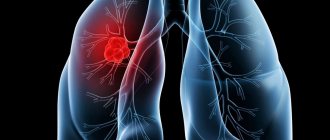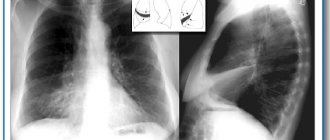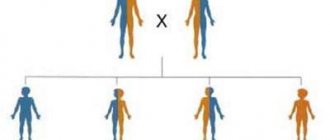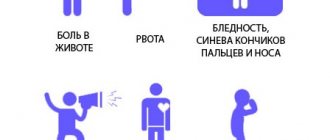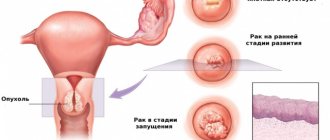Chronic bronchitis (CB) is one of the most common pathologies of the respiratory system, along with pneumonia, bronchial asthma, COPD and bronchiectasis. According to statistics in recent years, there is a general trend towards an increase in the number of registered cases of this pathology, which, of course, is largely due to earlier detection during clinical examination of the population, improvement of diagnostic methods and their greater availability among different regions of the Russian Federation.
IT IS IMPORTANT TO KNOW! Fortune teller Baba Nina: “There will always be plenty of money if you put it under your pillow...” Read more >>
Some readers do not know what the bronchial tree is and what its role is in the breathing process. So, it consists of bronchi of different calibers (orders), as well as bronchioles. The development of the inflammatory process leads to swelling of the bronchial mucosa, discrinia (mucus and sputum accumulate), spasm of smooth muscles, which significantly complicates the patient’s breathing. However, all these processes are reversible. With chronic inflammation in the wall of the bronchus, connective tissue grows, replaces it with typical healthy bronchus, and changes the structure of the epithelium of the mucous membrane. These processes are more difficult to suspend and level out.
Most often, CB is registered in men and older people. In the absence of proper treatment, ordinary inflammation of the bronchi can take a chronic form and occur with certain complications:
- irreversible bronchial obstruction;
- respiratory failure;
- bronchial asthma and bronchospasm.
According to medicine, the disease is one of the most common throughout the world: every third person on the planet is diagnosed with chronic bronchitis. It is not surprising that many of us are interested in questions about how to cure chronic bronchitis, how dangerous this disease is, what are the main signs of the pathology, what is its classification, and so on. We will try to give answers to these and other questions below.
Causes and symptoms
The causes of acute and chronic bronchitis are slightly different. The main causative agents of acute disease are viruses and bacteria. Infrequent culprits may be allergens, harmful substances, and fungi. Infection occurs through airborne droplets from a sick person (when talking, sneezing, etc.). Both types can transform into an obstructive form.
Chronic pathology occurs for the following reasons:
- negative living conditions (dust, chemicals);
- frequent relapses of respiratory infections;
- prolonged exposure to dry or cold air.
There are other reasons that increase the likelihood of bronchitis:
- hereditary predisposition;
- environmental factors;
- harmful climatic conditions.
The main symptom of acute obstructive pathology is a wheezing cough, accompanied by pain, burning in the chest, and sputum production. When it turns yellow-green, it is a sign of an existing bacterial infection; if it is clear or pale, it is a sign of a viral infection. Sputum comes out abundantly in the morning after sleep. Body temperature increases to 37.8 °C, and sometimes it does not exist at all.
Symptoms of the chronic form are constantly recurring acute bronchitis (2-3 times annually). The disease has a sluggish form with times of calm and exacerbation. At the time of exacerbation, the same symptoms are observed as in acute bronchitis. The worsening of the disease is more noticeable in spring and autumn, it is during this period that a person’s immunity weakens due to a lack of vitamins. The patient experiences lethargy and malaise. This condition lasts 14–21 days.
Type of bronchus with bronchitis
Variants of the course of the disease
The disease progresses in different ways. In some patients, chronic bronchitis is atypical, that is, without pronounced symptoms, in others, the disease progresses and exacerbates under the influence of various endo- and exogenous factors. As a rule, the symptoms of chronic bronchitis appear gradually. The clinical picture of the disease usually manifests itself in the form of a cough that occurs in the morning. As the pathology progresses, patients complain of a night and daytime cough, which intensifies in the presence of irritants (cold air, tobacco smoke, dust, etc.). The amount of exudate increases, and over time it becomes purulent or mucopurulent in nature. Some patients experience and progress to shortness of breath. In most cases, the presented pathology is complicated by bronchial stenosis and sclerosis of the bronchial wall.
Signs of exacerbation
A damp and cold climate provokes an exacerbation of the disease. Signs of exacerbation are chills, hyperhidrosis (increased sweating), increased cough. The addition of infectious agents (staphylococci, viruses, mycoplasmas, pneumococci, streptococci) worsens the course of the disease, which leads to the generalization of the inflammatory process to the deeper layers of the bronchial wall. As a result of exposure to bacteria, the secretory epithelium, as well as the muscle and elastic fibers of the bronchi and bronchioles, are damaged. Due to the accumulation of purulent exudate in the lumen of the bronchi, cough intensifies, shortness of breath, general malaise, fatigue, night sweats appear, and sometimes body temperature rises.
Possible complications
All complications of chronic bronchitis can be classified into two groups:
- diseases caused by the evolution (emphysematous expansion of the lungs, generalized pneumosclerosis, respiratory failure, hemoptysis, “pulmonary heart”);
- caused by infection (broncho-obstructive component, bronchiectasis, pneumonia, bronchopneumonia).
Chronic bronchitis often ends in disability.
- Acute pneumonia
The main signs of acute pneumonia include the following symptoms:
- chills;
- hyperfatigue;
- hyperthermia above 38 degrees;
- pain in the chest associated with the act of breathing;
- moist cough;
- fatigue;
- headache;
- myalgia;
- general weakness;
- shortness of breath;
- decreased appetite.
It can be noted that the main signs of bronchopneumonia are cough, hyperthermia, auscultation and percussion data, as well as x-ray and laboratory data. During auscultation, crepitus, moist rales, and decreased breathing over the affected area of the lung tissue are detected. Inflammation of the lungs with an acute or fulminant course is accompanied by fever. X-rays show changes in the lung tissue quite well. The presence of inflammatory processes in the lungs can also be identified by the blood picture: leukocytosis (the number of white blood cells increases), neutrophilia with a shift to the left, an increase in ESR.
- Pulmonary emphysema
The disease is characterized by pathological expansion of the lung parenchyma. Due to the development of pathological processes in the alveoli, they lose their plasticity, which ultimately leads to disruption of gas exchange in the lungs. The main signs of pathology include the following symptoms:
- diffuse cyanosis;
- shortness of breath;
- increase in chest volume.
Lack of O2 disrupts the functioning of all organs and systems in the patient’s body.
- "Pulmonary heart"
Sometimes chronic bronchitis is complicated by a pathology called “cor pulmonale”. This disease is characterized by an increase in the size of the right chambers of the heart. The listed pathological processes increase pressure in the pulmonary circulation, as a result of which the heart fills with blood and increases in volume. The main clinical signs of “cor pulmonale”:
- hyperhidrosis;
- shortness of breath, worsening when lying down;
- severe headaches;
- swelling of the veins in the neck;
- heart pain that is not relieved by nitroglycerin;
- presence of edema.
Without appropriate therapy, the disease progresses, myocardial dystrophy develops, which further aggravates heart failure.
Acute bronchitis
Acute bronchitis
The pathology is characterized by a short development, which can last from 2–14 days. The patient suffers first from a dry and then from a wet cough with sputum production. Acute bronchitis can be obstructive or non-obstructive.
The course of the disease is characteristic of various respiratory infections (ARVI). Often the cause of the disease is viruses, adenoviruses, sometimes the causative agent can be chlamydia, mycoplasma, or combined viral-bacterial infections. The pathology is rarely of bacterial origin. Inflammation is initially observed in the nasopharynx, tonsils, trachea, then moves down the respiratory system - the bronchi.
The virus is capable of causing the spread of opportunistic flora, enhancing infiltrative or catarrhal changes in the mucous membrane. The upper parts of the organ are damaged:
- hyperemia appears;
- swelling of the mucous membrane;
- dystrophic disorders are observed;
- separation of epithelial tissues.
Timely and correct treatment of the obstructive form of bronchitis has a positive result, the structure and functioning of the bronchi is completely restored. The disease is more common in childhood, as children are more susceptible to respiratory infections. Constantly recurring bronchitis contributes to development into the chronic stage.
General information
The main provoking factor in the development of bronchitis is:
- hypothermia;
- damage to the body by a viral infection;
- decreased physiology of the bronchial glands.
Prolonged development of the disease involves a pathological process in the lungs. There is an increase in the viscosity of the produced exudate, as a result of which the functionality of the villi of the mucous membrane decreases, which contributes to the stagnation of sputum.
This circumstance is an impetus for the activation of bacteria and viruses, which is accompanied by an increase in body temperature and the manifestation of the main signs of bronchitis. We will talk further about how to recognize bronchitis.
Chronical bronchitis
This long-term inflammation of the bronchi further intensifies and provokes structural damage and disorders of the bronchial tree.
The appearance of chronic bronchitis is associated with:
- with a poor ecological environment (toxic substances, air pollution);
- allergies among the population;
- smoking.
With prolonged influence of negative factors on the mucous membrane of the respiratory system, the following are formed:
- gradual disorders in the structure of the mucosa;
- decrease in local immunity;
- changes in the drainage activity of the bronchi;
- increased sputum production;
- hypertrophy of glands.
Intensification of sclerotic disorders of the wall leads to the formation of bronchiectasis. Damage to the air-conducting capacity of the bronchi significantly impairs lung ventilation.
Basic principles
Strengthening the bronchi and their resistance to the effects of pathological factors is the main goal of measures to prevent the development of the inflammatory process in them. Frequent bronchitis in adults and untimely treatment lead to serious complications - pneumonia, bronchial asthma, cardiopulmonary failure, emphysema (pathological expansion of bronchioles and pulmonary vesicles), purulent inflammation of the bronchi and others. Basic preventive measures:
- strengthening the immune system, improving the protective properties of the mucous membranes of the respiratory system;
- proper nutrition - intake of sufficient amounts of proteins, fats, carbohydrates, minerals, vitamins, water into the body;
- cessation of smoking, harmful working conditions;
- Spa treatment;
- timely treatment of concomitant diseases.
Immune stimulation
Ways to strengthen the bronchi are simple. It is important to carry out preventive measures regularly and use effective methods. These include:
- Hardening. This is an important procedure that helps mobilize the body's defenses in low temperatures. Air, water, sun are the main hardening factors. Regularity, dosage, gradualism, complexity are the main principles of hardening procedures.
- Ethnoscience. There are special herbal mixtures for the treatment and prevention of bronchitis . Medicinal infusions are prepared from them and consumed hot. Herbal teas are popular for strengthening the immune system.
- Taking medications. If prescribed by a doctor, you can take pharmacological drugs that stimulate the production of T-lymphocytes. These cells are an important part of the immune defense. Vitamin and mineral complexes have a general strengthening effect on the body. It is advisable to practice their use at the end of winter, early spring, when symptoms of hypovitaminosis appear.
Nutrition
At the first signs of illness (runny nose, cough, general weakness), you need to reconsider your diet. How quickly recovery occurs depends on nutrition. Food should be digested quickly and well. It should contain a large amount of vitamins and minerals. You need to eat small portions 4-6 times a day so as not to overload the intestines.
The diet must be followed for 3-4 weeks. It is important that the body directs all its forces to fight the disease or mobilize immune defense. For prevention and during illness, adults should include the following foods and dishes in their diet:
- potato;
- semolina;
- chicken bouillon;
- rich soups;
- lean meat and fish;
- salads from fresh and boiled vegetables;
- honey;
- sweet fruits;
- dried fruit compotes;
- fruit drinks;
- blackcurrant and raspberry jam.
Exclude from the dietary menu for bronchitis and its prevention:
- fried, spicy, salty, fatty;
- coarse porridge;
- toast, crackers;
- shortcrust pastry;
- tough meat;
- spinach, sorrel.
Rejection of bad habits
Cigarette smoke has a detrimental effect on the bronchial mucosa. Combustion products and resins block the secretory activity of the bronchial glands, their structure changes, and pathological changes occur. In smokers, bronchitis occurs in a chronic form, and the risk of developing malignant neoplasms increases. After suffering from an illness, it is necessary to get rid of a bad habit in order to avoid relapse.
Prolonged work in the cold with high air humidity causes spasm of blood vessels and a decrease in blood flow in the bronchi. Working in unfavorable conditions provokes atrophy of the bronchial glands and progression of pathology . This type of bronchitis in adults is called professional bronchitis. To prevent bronchial asthma, as a consequence of this type of disease, it is necessary to avoid exposure to allergens, hookah smoking, and inhalation of toxic substances.
Timely treatment of diseases
In some cases, the development of pathology is preceded by activation of a focus of chronic infection (for example, the oral cavity, the maxillary sinus). Pathogens, along with sputum and saliva, enter the respiratory tract. In most cases, this occurs at night when the epiglottis is relaxed. Considering this fact, it is necessary to promptly treat carious teeth, monitor the condition of the tonsils and oral mucosa, and get rid of a runny nose.
Types of disease
The disease is classified according to certain characteristics:
- Clinical development: acute, chronic bronchitis is observed.
- Depending on the severity, bronchitis can be mild, moderate or severe.
Classification of acute form
Based on the etiological sign, they distinguish:
- non-infectious basis (allergic causes, physical, chemical negative factors);
- infectious etiology (bacterial, combined, viral);
- unknown etiology;
- joint origin (addition of infection and the influence of physical and chemical agents).
The focus of the inflammatory process is recognized by:
- bronchiolitis;
- diseases with a predominant disorder of small, medium-sized bronchi;
- tracheobronchitis.
Purulent bronchitis
According to the nature of the discharge, bronchitis is:
- purulent;
- atrophic;
- catarrhal;
- combined – purulent-catarrhal.
This form of the disease is determined by the mechanism of formation: there are secondary and primary bronchitis.
Classification of chronic form
In accordance with the nature of inflammatory development, the following are distinguished:
- catarrhal;
- purulent.
According to the disorder in the functioning of external respiration, the disease is:
- obstructive;
- non-obstructive.
Halotherapy
One of the most modern methods of combating chronic bronchitis is halotherapy.
The procedures are carried out in specially equipped chambers, where optimal conditions of humidity and temperature are created, and the air is thoroughly cleaned and saturated with saline solutions. With the help of halotherapy, patients can completely get rid of mild forms of the disease, and with a complex course, significant relief is achieved, thanks to which a person can do without medications for a long time.
Halotherapy
The main factors causing the development of bronchitis
The main factors in the formation of acute bronchitis are:
Allergies cause acute bronchitis
- chemical agents - substances poisonous in the air: carbon monoxide, tobacco smoke, acid vapors, etc.;
- physical factors: moist, cool air, the effect of radiation, dust on the human body, a sudden drop in temperature;
- bad habits: drinking alcohol, smoking;
- genetic predisposition: allergies, congenital changes in the bronchopulmonary system;
- chronic infections in the nasal and oral cavity: tonsillitis, sinusitis;
- cardiovascular diseases.
The main cause of any bronchopulmonary diseases is smoking, including obstructive chronic bronchitis. People who smoke are 5 times more susceptible to bronchitis than non-smokers.
Smoking is an important cause of bronchitis
People who work in hazardous enterprises and inhale flour, cement, and wood dust are prone to chronic illness. The cause may be increased air humidity and uncomfortable temperature conditions. A high amount of harmful substances in the air, especially in large cities, leads to obstructive bronchitis.
Newly experienced pneumonia, bronchitis, acute acute respiratory viral infections, chronic pathologies of the nasopharynx and kidneys can subsequently provoke chronic bronchitis.
The infection is superimposed on existing damage to the mucous membrane of the respiratory tract by other damaging factors. Heredity plays an important role; it increases the likelihood of developing chronic bronchitis.
Features of the clinical picture
Signs of chronic bronchitis largely depend on the duration, phase of the disease and the presence of complications. Clinical manifestations of the disease:
- shortness of breath;
- difficulty breathing of the expiratory type (in the case of obstructive CB);
- dry and wet wheezing, which changes when coughing;
- symptoms of intoxication: weakness, lethargy, loss of appetite;
- low-grade fever (can persist for a long time);
- cough with mucopurulent or purulent discharge.
Bronchitis is dangerous for both children and adults. The symptoms of pathology depend on many factors:
- duration of illness;
- the presence of any complications;
- phases of development of the disease, etc.
At the initial stages of the development of the pathology, patients complain of a cough that occurs mainly in the morning. As the disease progresses, shortness of breath appears, first with physical exertion, and after a few years at rest.
Against the background of bronchial obstruction, cardiopulmonary failure develops.
Symptoms of exacerbation of non-obstructive chronic bronchitis manifest themselves as follows:
- hyperthermia;
- cough;
- headache;
- malaise;
- sputum production;
- sweating;
- myalgia;
- decreased ability to work.
In the initial stages of the disease, there is a dry cough. Chronic simple (non-obstructive) bronchitis is characterized by seasonal exacerbations. The discharge of mucous, watery sputum is a typical sign of catarrhal bronchitis. At the beginning of the disease, the cough does not bother the patient, but as the pathology progresses, it intensifies and becomes paroxysmal. The main symptom of purulent bronchitis is the release of purulent exudate, the amount of which depends on the prevalence and severity of inflammation in the bronchial wall. The key signs of chronic obstructive bronchitis are:
- dry or unproductive cough, initially mainly in the morning;
- shortness of breath of an expiratory nature (difficulty in exhaling), initially during physical exertion, coughing, change of weather, and then at rest;
- an increase in cough, shortness of breath and an increase in the amount of sputum during exacerbation;
- upon percussion, a boxy sound is heard, the auscultatory picture includes weakened breathing or it is harsh with a prolonged exhalation, whistling dry rales on exhalation;
- during exacerbation, moist rales may also occur;
- diffuse cyanosis.
If the disease is of infectious origin, the patient experiences symptoms of general intoxication of the body;
- digestive dysfunction;
- lack of appetite;
- headache;
- hyperthermia;
- general weakness.
Chronic obstructive bronchitis is dangerous for the patient’s health, since without appropriate therapy it is complicated by “pulmonary heart”, respiratory and heart failure. Asthmatic bronchitis is characterized by bronchial obstruction, which manifests itself mainly in the form of bronchospasm caused by sensitization and hyperreactivity of the bronchi.
Diagnostics
Bronchitis is diagnosed by the attending physician after a visual examination of the patient. The main criteria are complaints, based on them, the specialist makes a diagnosis. The main symptom is a cough with yellow or white sputum.
The diagnosis is determined according to the following criteria:
To determine the diagnosis, pneumotachometry is used
- A blood test helps to see the inflammatory process;
- X-ray of the lungs allows us to clarify the picture of the processes existing inside;
- pneumotachometry determines the speed of air flow during inhalation and exhalation.
Obstructive bronchitis can be recognized using several methods:
- examination by a doctor of the throat, listening to the chest;
- bouts of dry cough;
- whistling breathing, with long delays.
An auxiliary study is performed for signs of existing wheezing and a chest x-ray. Having determined the correct diagnosis, the doctor will prescribe drug therapy, and the patient is obliged to strictly follow it. Treatment is usually carried out at home.
Emphysema
Advanced inflammation of the bronchi often becomes the basis for the development of emphysema. The pathology is aggravated by irreversible changes in the lung tissues, which are formed due to prolonged narrowing of the airways.
The structure of the organ becomes flabby, gas exchange and air circulation in the lungs are disrupted. People diagnosed with chronic bronchitis experience long, difficult exhalation.
As a result, air pressure on the alveoli increases, they become denser and stretch.
The level of compression and stretching of the lung tissue is disrupted, and some areas of the lungs become noticeably inflated.
Important to know: How can you cure chronic bronchitis forever?
Symptoms of emphysema:
- dyspnea;
- increased chest volume;
- bluish coloration of the mucous membranes.
Cyanosis (cyanosis) occurs due to a lack of oxygen, causing the color of the skin and mucous tissue to change. Shortness of breath at an early stage appears only with severe physical exertion.
Over time, it becomes stronger and can be observed even if the person does not particularly strain. Breathing and range of motion are impaired, and pathologies of the heart, blood vessels and other vital organs develop.
Therapeutic measures
Having determined inflammation of the bronchi, it is necessary to immediately begin treatment. It is not recommended to carry out therapy on your own to avoid negative consequences.
Today, treatment of the disease with antibiotics is extremely rare. The exception is situations when bronchitis has developed into a complicated obstructive form or provoked concomitant pathologies.
Treatment involves the use of the following drugs:
Drug treatment of bronchitis
- expectorants;
- medications that reduce the viscosity of sputum;
- antihistamines - if bronchitis is allergic in nature;
- immunostimulants;
- in extreme cases, cough suppressants;
- vitamins.
Unfortunately, there is no antiviral drug that would help cope with bronchitis, but Interferon is sometimes used.
In combination with medications, the following measures have a positive result:
- physiotherapy;
- inhalation;
- massages;
- physiotherapy.
Inhalation for the treatment of bronchitis
Treatment of obstructive bronchitis
For therapeutic measures of obstructive bronchitis, medications that dilate the bronchi are used. The optimal bronchodilator to combat obstructive disease must meet the following requirements:
Atrovent for the treatment of obstructive bronchitis
- high performance;
- minimal number of side effects;
- maintaining results even after long-term use.
Inhaled anticholinergic drugs that act directly on the bronchi have these requirements. Medicines Troventol, Truvent, Atrovent have a bronchodilator effect and have almost no side effects.
These medications do not affect the cardiovascular system in the obstructive form. Atrovent therapy begins with two inhalations four times a day. A decrease in obstruction and normalization of the condition is noticed 7–10 days after use. Such drugs form the basis of long-term bronchodilator treatment. It is also recommended to use an inhaler with a spacer.
Treatment of acute bronchitis
Treatment of bronchial disease is systematic. Bed rest, regular airing of the room, and drinking more warm drinks are recommended.
The following medications will be required:
- Expectorants (Pertussin, marshmallow syrup).
- At elevated body temperature (Amidopyrine, Acetylsalicylic acid).
- Antihistamines, hyposensitizers (Diazolin, Diphenhydramine, Suprastin, Peritol).
- Antibiotics and sulfonamides are prescribed when pneumonia occurs (Levofloxacin, Amoxicillin, Macropen).
| A drug | Photo | Price |
| Pertussin | from 23 rub. | |
| Acetylsalicylic acid | from 9 rub. | |
| Diazolin | from 67 rub. | |
| Levofloxacin | from 133 rub. | |
| Macropen | from 304 rub. |
Treatment involves the use of herbal remedies, syrups, and inhalations.
Treatment of chronic bronchitis
Therapy involves many actions determined by the stage of development of the disease. Treatment of chronic pathology during an exacerbation involves eliminating inflammation and facilitating breathing. A number of manipulations are performed:
Breathing exercises for bronchitis
- stabilize heart function;
- normalize ventilation of the respiratory system and eliminate spasms;
- perform breathing exercises.
Several groups of medications will be required.
Antibiotics are used to kill infection activity. The duration of treatment is individual for each person. Antibacterial drugs are selected taking into account the susceptibility of the sputum microflora.
In order to remove mucus, Bromhexine and Lazolvan are prescribed.
Bronchospasms are relieved with the drug Atrovent - it helps to liquefy and remove mucus.
| A drug | Photo | Price |
| Bromhexine | from 9 rub. | |
| Lazolvan | from 171 rub. | |
| Atrovent | from 228 rub. |
Inhalations with onion or garlic are provided. Juice is squeezed out of onion or garlic and combined with a 0.25% solution of novocaine in a ratio of 1/3. Inhalations are carried out twice a day, the course is 20 procedures.
Along with treatment of the disease, conservative sanitation of areas of nasopharyngeal infection is carried out.
Sanatorium treatment and climatic conditions
Sanatorium treatment is best carried out during the seasons of greatest risk of exacerbations (beginning of spring, end of autumn). It is advisable to carry out rehabilitation 1-2 times a year for 3-4 weeks .
There are special sanatoriums for patients with bronchitis
For patients with chronic bronchitis, sanatoriums that qualify for respiratory diseases are suitable. They are usually located in countries with a continental, semi-mountainous, Mediterranean climate, on the shores of seas, rivers or in coniferous forests. They are characterized by a warm climate with moderate humidity levels.
Sanatorium-resort treatment is certainly a highly effective method of preventing chronic bronchitis, which should not be neglected. You can read about this in detail here.
Possible complications
Bronchitis is an inflammatory disease of the bronchi, which without timely and proper treatment can cause complications:
Bronchial asthma is a complication of bronchitis
- bronchial asthma;
- cardiovascular failure;
- bronchiectasis pathology;
- pulmonary hypertension;
- bronchopneumonia - appears due to weak immunity and is a consequence of acute bronchitis;
- chronic stage of this disease;
- emphysema;
- obstructive disorders of the bronchial tree.
When a cough is accompanied by the discharge of sputum with blood clots, it is recommended to check for the presence of dangerous pathologies - lung cancer, tuberculosis.
Some statistics on the incidence of bronchitis
Bronchitis, the symptoms of which manifest themselves in different ways, is one of the most common diseases of the respiratory system. In urban conditions, the following forms of the disease appear among the adult population:
- acute, ICD 10 - J20 (8.4 patients per 1000 people);
- chronic (10.9 patients per 1000 people);
- combination with pulmonary emphysema and pneumosclerosis (4.3 patients per 1000 people).
As a rule, the acute form of bronchitis (ICD 10 J-20) is registered in adults under the age of forty years, the chronic form - in people over forty years of age. In addition, the disease occurs more often in men than in the female half of the population.
Prevention
The main preventive measure for primary or secondary bronchitis is the restoration of the body's defenses. The following rules are recommended:
It is worth giving up alcohol and smoking to prevent bronchitis
- during the cold season, take immune-strengthening agents and vitamin complexes;
- promptly eliminate foci of infection;
- get a flu shot (the disease is often caused by a viral infection);
- eliminate negative household factors (dust, dirt, chemicals);
- follow the rules of personal hygiene;
- eat healthy and balanced;
- stop smoking, alcohol;
- perform moderate physical activity;
- harden the body.
Carrying out breathing exercises helps remove mucus and restores breathing. Physiotherapy is carried out in the last stages, when the symptoms are no longer severe. Obstructive bronchitis should be treated with UHF therapy and electrophoresis.
The main thing in the treatment of bronchitis is to take timely effective measures at the initial signs of the disease and monitor recovery.
Related video: Bronchitis
Strengthening the immune system
You should take care of your immunity. Although scientists today say that the antiviral effect of ascorbic acid is greatly exaggerated, in fact, vitamins are very necessary for natural protection, especially in winter. It is not even necessary to take vitamin complexes; it is enough to balance the diet by including seasonal vegetables, citrus fruits, and drinks made from dried or frozen berries.
A lot of vitamin C is found, for example, in black currants and rose hips. Also, to strengthen the immune system, it is important that the body receives enough protein, preferably of animal origin.
Features of therapy in the elderly
Due to the decrease in the protective functions of the body in older people and the presence of comorbid conditions in them, the treatment of chronic bronchitis is complicated. Elderly patients in most cases are characterized by a weak response of the body to the therapy used and a high predisposition to side effects. Oxygen therapy is also known to be poorly tolerated by most older people. This makes it difficult to select adequate therapy and requires special caution in the use of medications. It is optimal to treat exacerbations of chronic bronchitis in adults over 65 years of age in a hospital setting, where almost constant medical supervision is available.
Treatment of children
Bronchitis in children usually occurs in an acute form with characteristic symptoms and, with a properly designed treatment regimen, is cured without transforming into chronic. It is believed that CB can develop latently for years and manifest only decades later in an already complicated form.
The discovery of chronic bronchitis in children is an extremely rare event and beyond the realm of possibility. If such a situation does arise, to maintain remission in a child with chronic bronchitis, the same methods are used as in adults according to clinical recommendations. The dosages of medications and the frequency of their use should be adjusted according to the age of the child.
